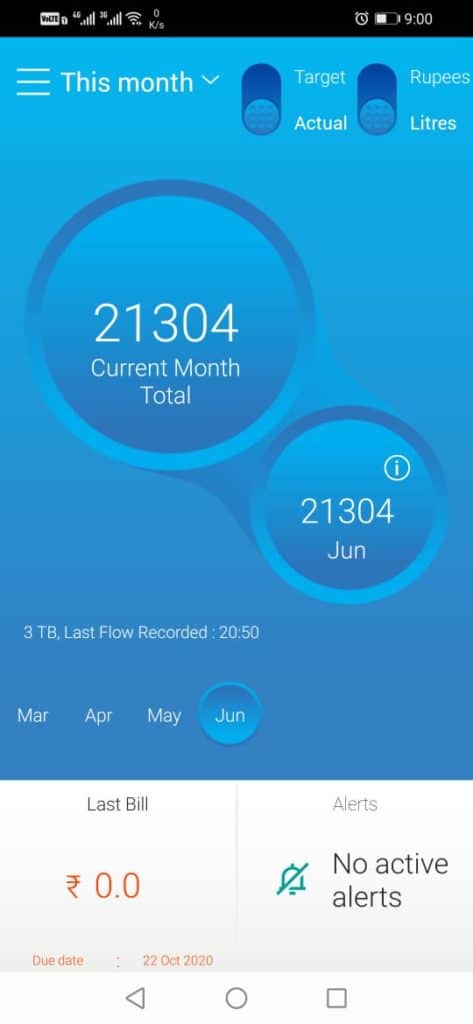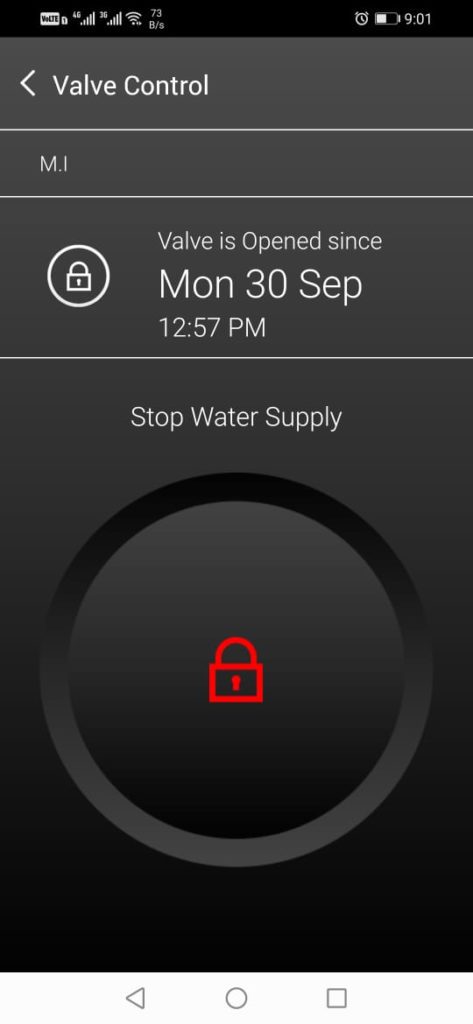It has been two months since Geetha Foundation apartments in Puzhuthivakkam installed water meters at a cost of Rs 8500. Since then, the apartment of five flats has been able to save 100-150 litres of water in a month. As part of the installation, a float switch sensor is added to the overhead tanks which sends an alert as soon as water levels reach a particular level. This stops the roof/storage tank from overflowing, resulting in significant conservation of water.
“Water level in the storage tank is maintained at the level of the float valve inside the tank. Once water touches it, the motor automatically turns off and when the water levels go down, it is turned on again,” explained Mahesh Kumar, who resides in one of the flats. “Earlier, we would know that the tank was full only when it overflowed. Even though we used to turn off the motor as soon as we came to know, at least three to five litres of water a day would still be wasted because of overflow,” said Mahesh Kumar.
In a city forever fighting the spectre of a looming water scarcity, residential water meters are a revolution much awaited. But even though there is a law on paper, water meters in residential properties in Chennai are still not common enough. Metering is still in the early days of experimentation, with only some apartment complexes opting for it.
A cost-cutting measure
In apartments with no meters, water bills are divided equally among all the flats irrespective of the quantity used or the number of residents. “To get [supposed] justice for the money they pay, some occupants — even the educated — go to an extent of keeping taps open, when they go out,” reveals an article on the India Water Portal. But those who have installed water meters find that it not only helps them save money, but also makes the cost burden ‘fair’.
Jain Sasvat apartments in Adambakkam (with 92 flats) saves a considerable amount of money every month, since installing a water meter in 2019, when Chennai found itself in the midst of an unprecedented drought. Opting for water meters was a unanimous decision. “Our borewells were exhausted and we were buying water from the tankers. We felt water meters would help us calculate the consumption per unit fairly. A 2BHK apartment with five people will consume more water than a 1BHK with one person. It is not fair to put them all on the same bill,” said Thiyagarajan D, Secretary of Jain Sasvat Flat Owners Association.
“From Rs 2000 a month, my monthly water bill has now come down to Rs 500,” says Bharathi Ramakrishnan, another resident of Jain Sasvat.
As the water piping system had to be re-engineered to install water meters, a sum of Rs 15,000 was spent by each apartment unit for the same as a one time initial investment. But this investment can be prevented or curtailed if the buildings are planned at the outset to have distribution lines in place that can accomodate water meters. A separate water line for each flat in an apartment is the primary requirement for installing a water meter. In apartments where common piping is provided for many units, the old pipe routings should be replaced with separate water lines for each unit.
Thus, buying or renting a water meter could involve a significant one-time initial investment, but it is well worth it in the long run. The actual cost is comprised of the cost of re-engineering water pipelines, hiring the meters and a sum towards rental charges every month, which is included in the maintenance paid by residents. “We pay around Rs 8400 as monthly rent charges for 92 homes in Jain Sasvat,” says Thiyagarajan.
Saving a precious resource
Cost-effectiveness and savings may be the biggest draws when it comes to popularising water metering as a solution. But its real utility lies perhaps in the direct and indirect ways in which it leads to conservation of water.
Through its mobile application, every water meter lets users know their real-time consumption of water. It can even be used to shut off or resume water supply to respective homes depending on the threshold limit set.
Bharathi says that their solar-powered, GPS water meter has made her a more judicious user of water. The meter alerts the consumer on the smart phone whenever the daily consumption exceeds a certain limit or whenever there is continuous use of water at a stretch, beyond a few minutes. That is what helped her identify a leakage in the toilet flush system. “Even when no taps were open and there was no other usage, I got an alert on my phone. It was this that led us to the flush leak. Before that, I had no idea that the toilet flush was consuming such a lot of water. We got it fixed and saved further loss of precious water,” she said.
Bharathi’s experience actually bears out what was mentioned in the article on India Water Portal: “In apartments without meters, leaking taps are not repaired immediately, even for months together, as the loss of water is not a direct loss for the occupant,” added the report from the India Water Portal.
Read more: Seven reasons why Chennai should have seen this water crisis coming

Why has Chennai been slow in the game?
The practise of metering water is not seen as commonly in Chennai as in Bengaluru, Mumbai or New Delhi. Proactive water supply departments and aware citizens have already brought about some change in these metropolitan cities. But as mentioned earlier, its adoption in the residential segments of Chennai is still low.
“Water meters have picked up fast in Bengaluru over the past five years. But township builders in Chennai have just begun to follow other metropolitan cities in making provisions for water meters,” noted Ganesh Raja, G S V Microtech Private Limited, a firm that manufactures water meters and provides technical solutions for water conservation. This, despite the Chennai Metropolitan Water Supply And Sewerage Act, 1978 [Chapter VI, clause 47(1)] noting:
“For calculating the amount payable by the owner for the consumption of water supplied by the Board, the Board may determine the quantity consumed on the basis of reading recorded by a meter installed in the premises.”
Earlier, attempts by the Chennai Metro Water Supply and Sewerage Board (CMWSSB) to encourage metering did not meet with enough success for a host of reasons. “Those meters were not durable. As most of them were mechanical, Metro Water engineers had to go personally to the spot to calculate the water usage. That was a dampener,” said Ganesh Raja.
There are other drawbacks of mechanical meters. “They become dysfunctional if clogged during the rains. In general, it is difficult to locate the defective / non-functioning meters immediately and this affects readings. Whenever the meters don’t function, billing is made based on average consumption till they are rectified or replaced,” said V G Ramaswami, Superintendent Engineer, Chennai Central, CMWSSB.
Raja, however, points out that digital meters, which make it easy for engineers to monitor usage, are now available in the market (as are being used by the apartments mentioned above).
Read more: How this Bengaluru apartment cut water consumption by 52% with just three measures
Citizen role
According to the data from CMWSSB, a total of 17,794 residential water connections were provided in the year 2020-21. However, none of them has requested a water meter from the board. In contrast, CMWSSB has installed 12,708 water meters in commercial segments such as hotels and industries over the same period. While a few apartments are opting for water meters, it is still largely an alien concept in individual houses. This cultural change is what can play an important role in the uptake of metering.
“Why should it take a calamity for us to take steps towards change? A mass campaign on water meters in residential and commercial segments will help us get through dry days in future,” said D Thiyagarajan. But bringing about that shift has its own set of challenges. “Even if one family in a 100-flat apartment doesn’t come to a consensus, the apartment associations cannot go for it. It takes time to change deep-rooted mindsets,” said Yaswanth Kumar, secretary of an apartment association in Velachery.
A start could be made by convincing the utility companies or external managing agencies that manage water and other services in large apartment complexes. For these companies, water meters is a new concept and may entail changes in the mode of operation that they have been traditionally following. But if they welcome water meters, citizens can be easily convinced too, say those who have made the switch.
“New apartment builders must design houses suited for installing water meters. In most apartments, there are multiple inlets (pipe connections) for each house that add up to the cost as a meter has to be installed for all inlets,” said Ganesh Raja.
Water meters should be installed uniformly across Chennai, said V S Ramaswami, and so upon the implementation of the 400MLD desalination plants in Chennai, CMWSSB will mandate meters for all customers. Since it is still uncertain when those projects will be completed, it is only a push from citizens that can boost adoption of water metering in the city in the short term.


Most of the residents of apartments can afford Rs.100 per month. Save 100 lit per month?!This is much ado about nothing.
We are in the heart of Chennai in Gopalapuram
we have never got Corporation water till now.
This system excellent welcome to Chennai.Mark my word future this will help when shortage water for government to run.
We are in the planning stage of getting water meters done. Hope to get it soon.
I would like to install water meter for my apartment because I have been paying more than what I consume. few of the neighbors who consume more are making us pay for the water we don’t use also they don’t include children. Houses with newborns consume more water than houses with just the adults. Since we have a common plumbing we are unable to fix a meter seperately. Is it possible to do it for my house alone? And pay the amount accordingly?